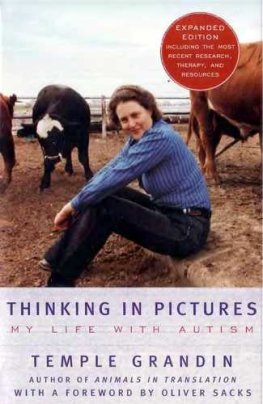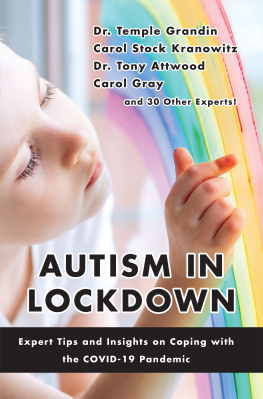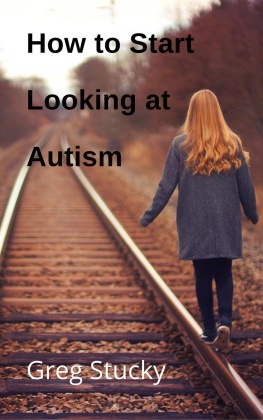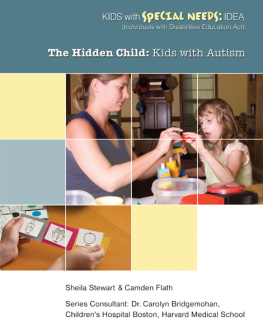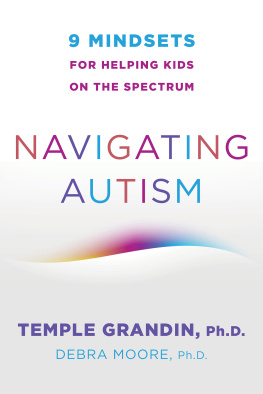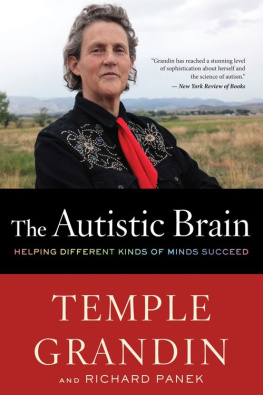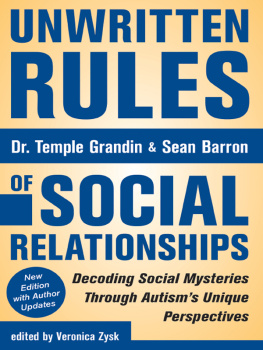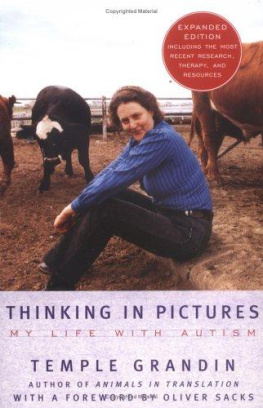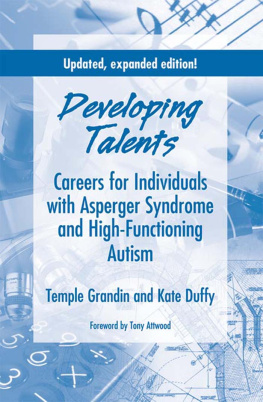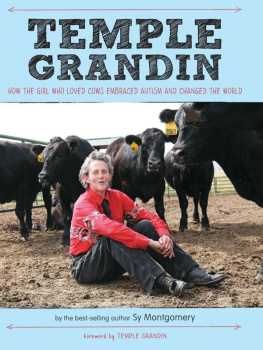Praise for
Hello, Stranger
insights from a time when a young person with autism grew up in a world where nobody understood them!
Temple Grandin, author of Thinking in Pictures
An extraordinary look at autism from the insideby turns heartbreaking, uplifting, illuminating, witty, and wise.
Steve Silberman, author of NeuroTribes: The Legacy of Autism and the Future of Neurodiversity
Remarkably detailed, stunningly honest, and, in the end, deeply moving. A unique look into the heart and mind of someone who never fit in.
Rachel Simon, author of Riding the Bus with My Sister
A testament to neurodiversity and a call to acceptance.
Martha Leary, author of Autism: Sensory-Movement Differences and Diversity
This book is a winner for all to read. It clearly reveals the contrast between the world view and experiences of one remarkable person with autism and those around her
Nancy Minshew, MD, founder, Center for Excellence in Autism Research at the University of Pittsburgh
An uncommon soul navigating the pain and triumph of self-discovery.
William Stillman, award-winning author of The Soul of Autism and Empowered Autism Parenting
As sweet and honest and painful and true and illuminating as any personal story you will ever read.
Paula Kluth, Ph.D., author of Youre Going to Love This Kid: Teaching Students with Autism in the Inclusive Classroom
Copyright 2018 by Barbara Moran and Karl Williams
Photos property of Ruth Moran and used with permission.
All rights reserved. No part of this publication may be reproduced, stored in a retrieval system, or transmitted, in any form or by any means, electronic, mechanical, photocopying, recording, or otherwise, without the prior written permission of the publisher.
Library of Congress Cataloging-in-Publication Data
Names: Moran, Barbara, 1951 May 29- author.
Title: Hello, stranger / by Barbara Moran ; as told to Karl Williams.
Description: Georgetown, Ohio : KiCam Projects, [2018].
Identifiers: LCCN 2018057782 (print) | LCCN 2018059924 (ebook) | ISBN
9780999742266 (ebook) | ISBN 9780999742259 (paperback) | ISBN 9780999742266
(ebook)
Subjects: LCSH: Moran, Barbara, 1951 May 29---Health. | Autistic
people--United States--Biography. | Autism spectrum disorders.
Classification: LCC RC553.A88 (ebook) | LCC RC553.A88 M668 2018 (print) | DDC
616.85/882--dc23
LC record available at https://lccn.loc.gov/2018057782
Cover and book design by Mark Sullivan
ISBN 978-0-9997422-5-9 (paperback)
ISBN 978-0-9997422-6-6 (e-book)
Printed in the United States of America
Published by KiCam Projects
www.KiCamProjects.com
Table of Contents
Introduction vii
Prologue xiii
Part One: The Years with My Family
One: When I Was Little
Two: Gas Pumps, Geysers, and Traffic Lights
Three: A Horrible Driven Feeling
Four: Dr. Horowitz, Alias Frank Sinatra
Part Two: Menningers: The Hospital
Five: At First It Seemed Like a Great Place
Six: Drifting Off to La-La Land
Seven: You Push People Away
Eight: Barbara, You Have to Tell Me
Nine: On Drugs
Ten: Does God Really Exist?
Eleven: Metaphors and Subconscious Anger
Twelve: Whitney Hall
Thirteen: The Older Girls
Fourteen: Cathedrals
Fifteen: My First Visits Home
Sixteen: Fancy Clothes and Safe Men
Seventeen: To Get Out of Menningers
Eighteen: Traffic Lights and Tornados
Nineteen: Jealousy
Twenty: Hayden High School
Twenty-one: Some Kind of Incentive
Twenty-two: Youve Chosen to Be Mentally Ill
Twenty-three: Riccardo
Photos
Part Three: Menningers: The Foster Home
Twenty-four: Life with the Harrisons
Twenty-five: Troy
Twenty-six: Fantasy Will Set You Free
Twenty-seven: Ramada Inn
Twenty-eight: It Chose Me
Twenty-nine: After the Social Club
Thirty: Bertram
Thirty-one: The Nursing Home
Thirty-two: The Evangelical Church
Thirty-three: Cornelius
Thirty-four: Airplanes
Thirty-five: Hobie
Thirty-six: Linda
Thirty-seven: Thats a Crutch
Thirty-eight: Moving Out
Part Four: On My Own
Thirty-nine: Rooney
Forty: The Naturopath
Forty-one: Autism
Forty-two: Tables
Forty-three: Kathy Grant
Forty-four: Drawing
Forty-five: Conferences, Jobs, Noise, Apartments, and Understanding
Forty-six: Forgiveness
Acknowledgments
Introduction
Introduction
By Karl Williams
You wont find much in this book on theories about or treatment for autism. In a sense, this work is the byproduct of a friendship. I met Barbara Moran when my wife invited Barb and her sister, Ruth, to tell Barbs story at a conference in Hershey, Pennsylvania.
Born in 1951, Barb had clearly been very bright, but once she started school, her teachers might have used the word undisciplined to describe her. The term autism had only recently begun to appear in medical journals in the early Fifties, and beyond blaming the parents (the phrase refrigerator mother dates from this period), there were few theories and no help. And so Barb ended up trapped in the mental health system for decades, misdiagnosed, until Ruth became a doctor.
I was fascinated. And there was no separating Barbs story from Barb herself quite a character with her outlandish clothing choices, her outspoken ways, and her colorful drawings of traffic signals and cathedrals with spindly arms and legs and open-book faces.
Over lunch, following the conference in Hershey, we talked about working on a book together.
Ive written two as-told-to autobiographies with leaders in the self-advocacy movement (people with intellectual disabilities working for respect and civil rights). Using transcriptions of recorded conversations, I removed all my questions and comments and worked exclusively with the words of those two remarkable men in order to render their stories in print.
Barb and Ruth agreed we would work in the same way: from conversations with Barb, as well as with Ruth and their mother, Mrs. Moran. We also used the detailed notes Mrs. Moran wrote for a psychiatrist on Barbs development from birth through her early years. (To protect the privacy of certain individuals in the story, names and identifying details have been changed.)
Barbara Moran is a very intelligent witness to the misdeeds that have been done in the name of helping. She is a survivor; shes been to the brink and has come back to tell us about it. Barb has an artistic spirit. From the start, she was going to do things her own way, because, as she says, other people mostly seemed boring to her. Human beings feel an urgent need to give names to things. Were hoping to gain some understanding and control in this baffling world in which we find ourselves. And so, at this point in time, the most reasonable approach seems to be to group people such as Barb in the category autistic. Barbs story attests to the value of such an approach. But it is just as true that Barb, rather than acquiescing in varying degrees, as many of the rest of us do, to the deeply grooved path of the culture weve been born into, is one who, as an artist, set out on her own path.
Barb still spends a good deal of time trying to express what has happened to her and how it made her feel. She imagines how things might have gone better for her even to the point of mapping what is currently understood onto situations she was forced to live through in the past. Shes still reeling from the major experience of her life: the worlds colossal misunderstanding of who she is.



